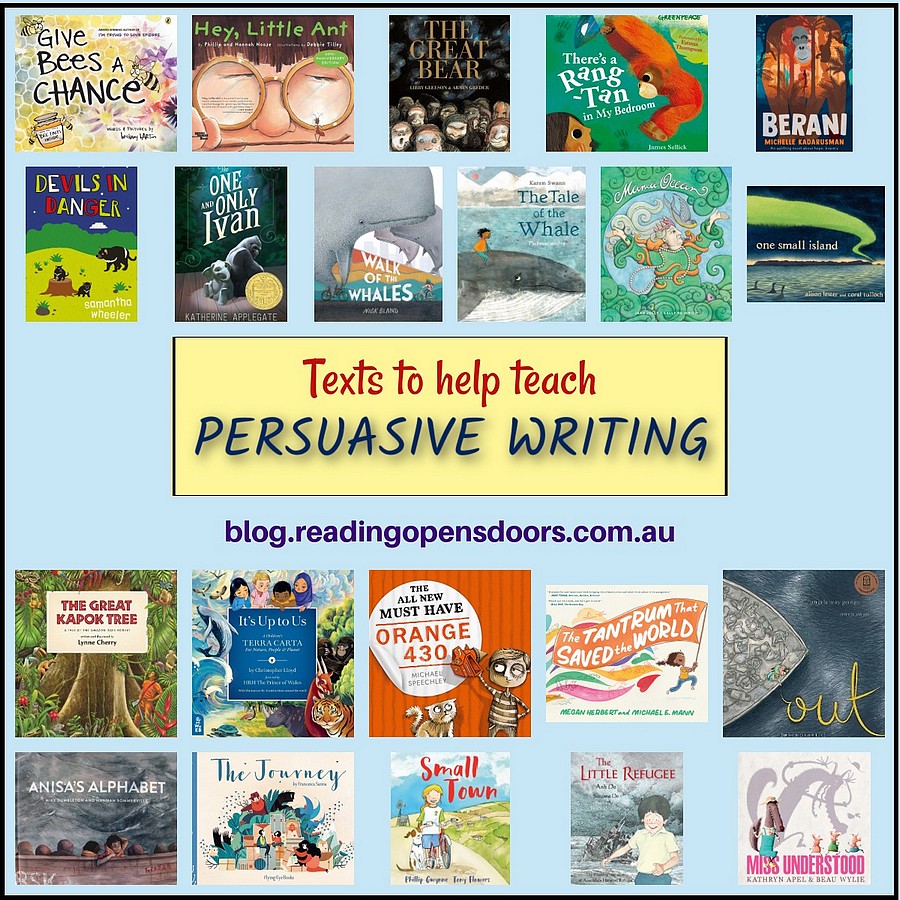
The following collection of books could be used to help teach persuasive writing and these titles include themes relating to animals (mostly animal rights and endangered animals), the environment, sustainability and refugees. A fractured fairy tale is also included. This list is by no means exhaustive and as always I am very keen to hear of any other books you would suggest should be included.
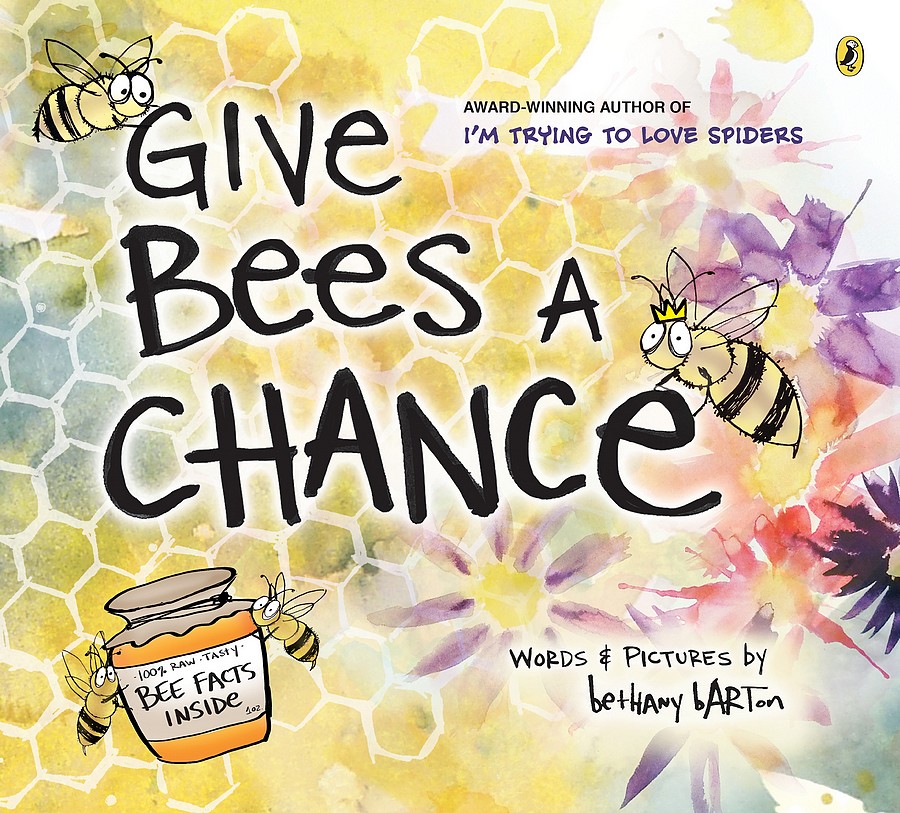
In this informative and witty picture book, Give bees a Chance by Bethany Barton, the narrator who is quite the bee expert attempts to persuade Edgar that bees deserve a chance and this argument is supported with lots of facts about bees to illustrate just how special and valuable they are. Edgar needs some convincing as he has recently been stung by a bee and this experience has left him scared of them. There is information about: the different types of bees (there are 25000 different types), the three different types of honey bees and their jobs, their anatomy, history dating back millions of years, an explanation of how honey is made, reasons why bees sting, beekeepers and what they wear to protect themselves, the bees impact on the food chain, threats to their species and ways to support their population.
This visually driven nonfiction book containing cartoon style illustrations, with text cleverly laid out makes the information accessible and digestible for a younger audience.
Bethany Barton has also written and illustrated the following titles: I’m Trying to Love Spiders, I’m Trying to Love Math, I’m Trying to Love Rocks, I’m Trying to Love Garbage.
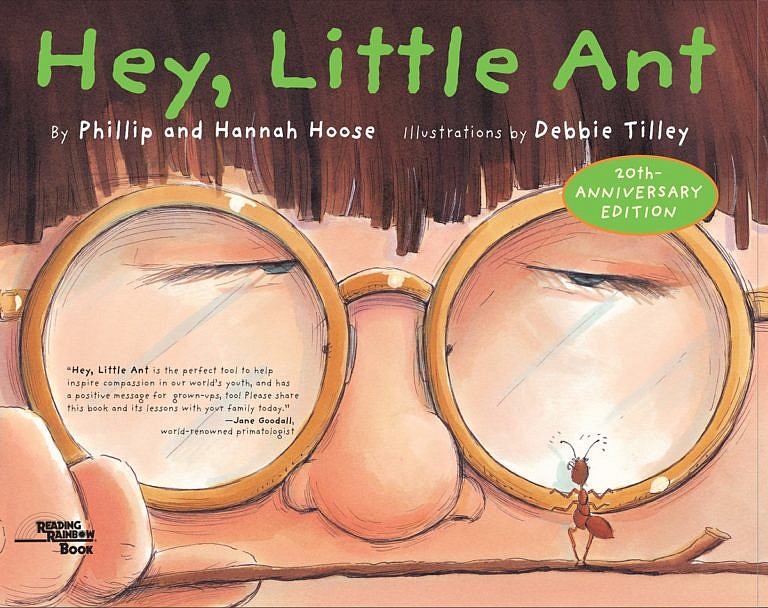
In the picture book, Hey, Little Ant by Phillip Hoose, Hannah Hoose and illustrated by Debbie Tilley the reader meets a terse young boy threatening to squish an ant with his shoe. Then a conversation takes place between the persuasive ant that puts forth numerous arguments as to why the boy should not follow through on his threat and he attempts to educate the boy about the similarities they both share. The misguided boy refutes the ants arguments based on his experiences with ants. The story has a twist at the end that is sure to inspire lively conversations and debate.
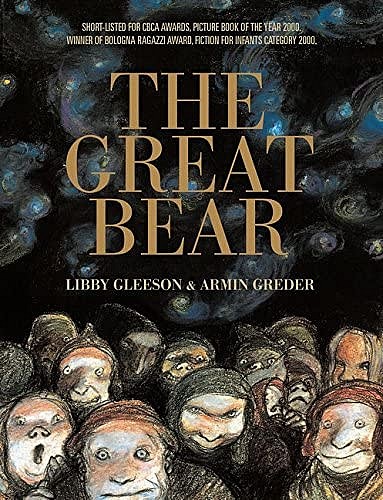
The Great Bear by Libby Gleeson and illustrated by Armin Greder, is a deeply moving, richly layered and confronting picture book containing two stories – that of a bear who is held captive and forced to perform, the bear is illustrated in line sketches on the left hand pages at the beginning of the story. Alongside the bear’s story are the throngs of people demanding to see the bear dance and they resort to cruel and inhumane measures to ensure this happens, depicted in dark colours. This is the bear’s courageous story about being held captive, tormented to dance and then the bear escaping. The first half of the story contains sparse text and the second half of the book is wordless with the pictures telling the story.
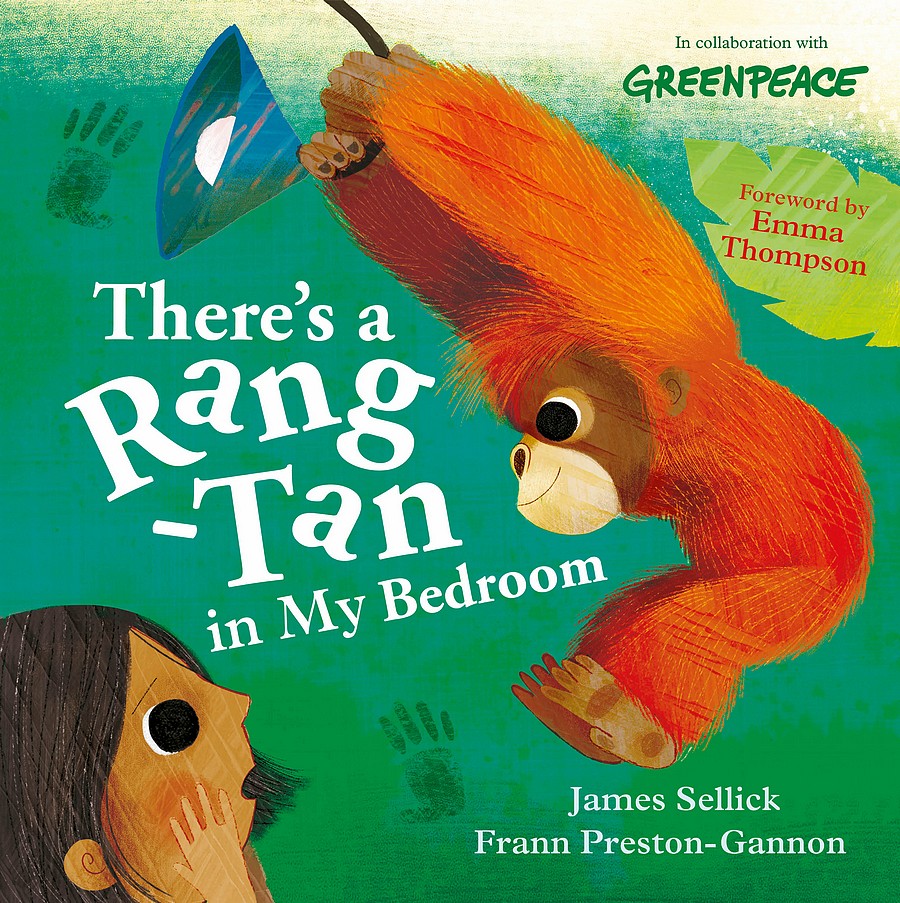
There’s a Rang-Tan in My Bedroom by James Sellick and illustrated by Frann Preston-Gannon (published in collaboration with Greenpeace) is a story about the destruction of rainforests to plant trees for palm oil production and the impact this is having on the orangutans. This book contains a foreword by Emma Thompson where she briefly discusses the destruction of the rainforest in Indonesia, the planting of palm trees and she calls for action to be proactive about causing change. This story is told in rhyme and begins with a young girl surprised to discover an orangutan in her bedroom. This orangutan is objecting to the chocolate, shampoo and cookies in the house. The girl is curious as to why the orangutan is there and wants to hear the orangutan’s story. The orangutan tells the girl that there are humans in the forest, destroying the trees for cosmetic and food products. The story continues with the impacts this has on the orangutan and its family. After hearing this information the young girl vows to save the orangutan’s home. She sets about sharing the orangutan’s story and inspiring others to join the cause to become activists for change. After the story there is further information and facts about orangutans, palm oil production (including palm oil grown responsibly) and ways that readers can help, including practical suggestions and useful information to assist children write a campaign letter. This is an excellent book to inspire further conversations and research into the plight of the orangutan as well as irresponsible palm oil production.
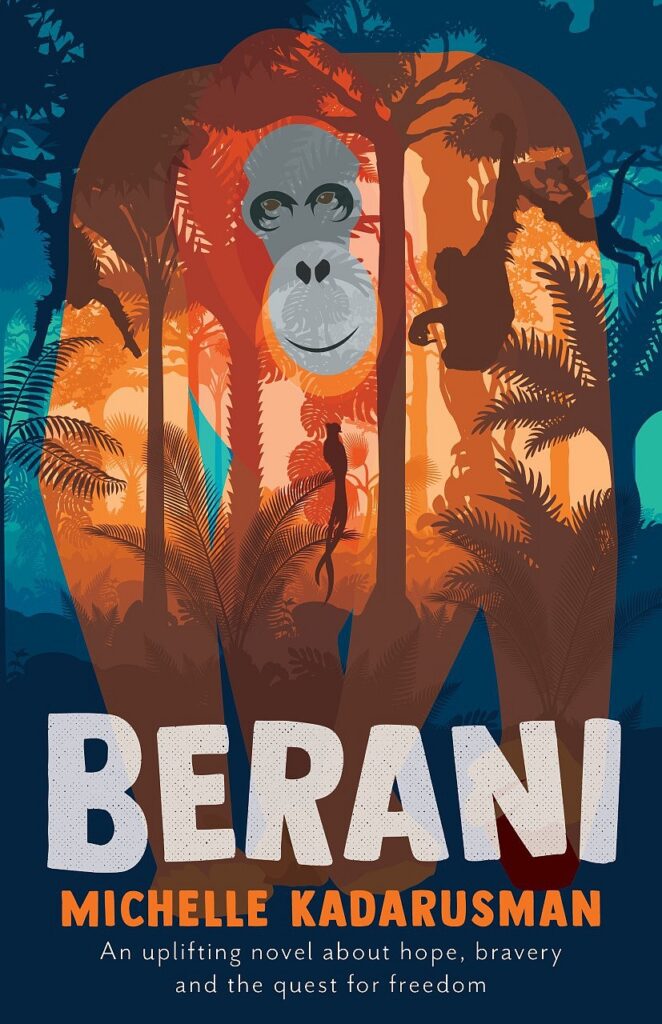
Berani by Michelle Kadarusman is an incredibly moving and inspiring eco-fiction title, recommended for readers 8-12 years. This story is set in Indonesia and is about two courageous children who are driven to release Ginger Juice, an orangutan held in captivity at Warung Malang restaurant. The commitment and the circumstances that surround these children, means that their advocacy faces many challenges and prejudices, it takes unwavering courage, especially given the possible consequences they could face determined by their decisions and actions. Three voices (in separate chapters) seamlessly weave this story together, those of Malia Kusarto, Ari Arjuna and Ginger Juice’s. This story highlights the power that an individual has to make a difference and more than that, the far-reaching ripple effect of one’s actions when they display conviction and stand up for what they believe in. This story is a wonderful gateway to many discussions centring on moral dilemmas.
At the end of the story, an author’s note explains that this book was inspired by a childhood experience Michelle and her brother shared where they did help rescue an orangutan that had been held captive in a cage at a restaurant in the village of Malang.
A detailed review for Berani including a link to teachers’ notes has been written in an earlier Reading Opens Doors blog post here.

Devils in Danger by Samantha Wheeler and published by University of Queensland Press (UQP) is an engaging and inspiring wildlife story about Tasmanian Devils and the quest to educate a community about them. It’s also a story about being devoted to a cause and the challenges, as well as the positive and negative impacts that can arise when you defend something that is not necessarily popular or is misunderstood.
This story is set in a small coastal town in Tasmania and begins with unprecedented events suddenly occurring; furious screams in the night and clothing items mysteriously disappearing. It is eleven year old Killarney who discovers the unlikely culprit in the form of a Tasmanian devil denning under her family’s home. While Killarney is captivated by this creature and smitten by its endearing features, it soon becomes apparent that not everyone shares her opinion about these animals. Many of the people in her town are misinformed about Tasmanian devils and this lack of knowledge sparks fear, threats, rumours, intolerance and unkindness in an attempt to rid the town of this Tasmanian devil and her joey’s.
A detailed review for Devils in Danger including a link to teachers’ notes has been written in an earlier Reading Opens Doors blog post here.
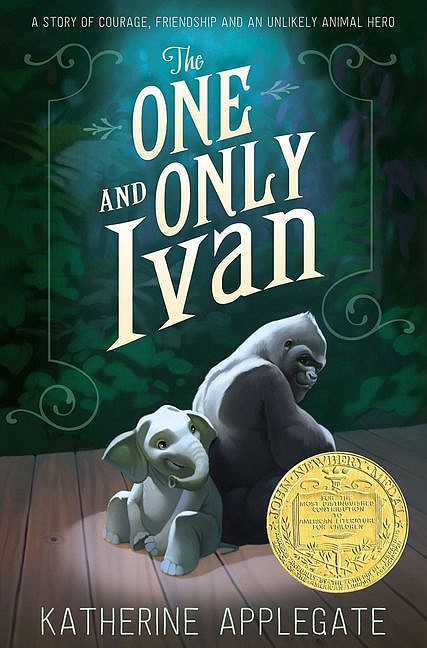
The One and Only Ivan by Katherine Applegate is about friendship, hope, courage and seeing possibilities. Ivan is a silverback gorilla who lives at the Big Top Mall and Video arcade with several other animals who are all dear friends. They spend their days in captivity, performing for the shoppers. Ivan communicates through his art and uses his art to make a difference for the captive animals. Ivan is the narrator and his observations about the humans that pass by are fascinating and insightful. This book will make you laugh with its heart warming and tender moments as well move you during the heart breaking times.
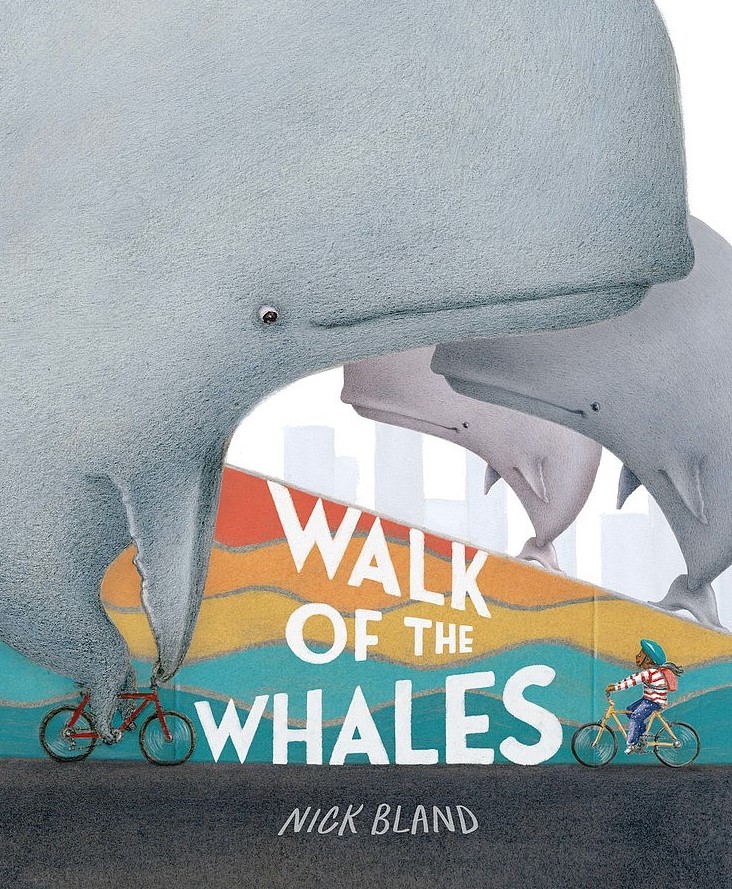
Walk of the Whales by esteemed book creator Nick Bland will inspire children to think about pollution in the ocean in a new and unexpected way and from the perspective of the whales. This highly entertaining and creative book tells the story about the whale population who took it upon themselves to suddenly leave their homes and walk out of the ocean to occupy the cities and towns. This brought much joy to the children, however this move had a polarising effect on adults as some people gained from this in the short term (like the fish seller who couldn’t keep up supply), while others were not at all impressed by the gigantic creatures wreaking havoc on their services and experiences.
As time passes the negative impact of the whales in the cities grows and frustrations mount as people’s quality of life deteriorates. The economy then suffers as businesses are forced to close and people have to find employment in new industries. Frustration turns to anger and people take to the streets to protest. The whales are vilified. Until one astute and courageous girl uses her voice to question the whales about their decision to live on the land. The whales’ response is powerful and in a non-didactic way contains an important environmental message.
A detailed review for Walk of the Whales and activity suggestions have been written in an earlier Reading Opens Doors blog post here.
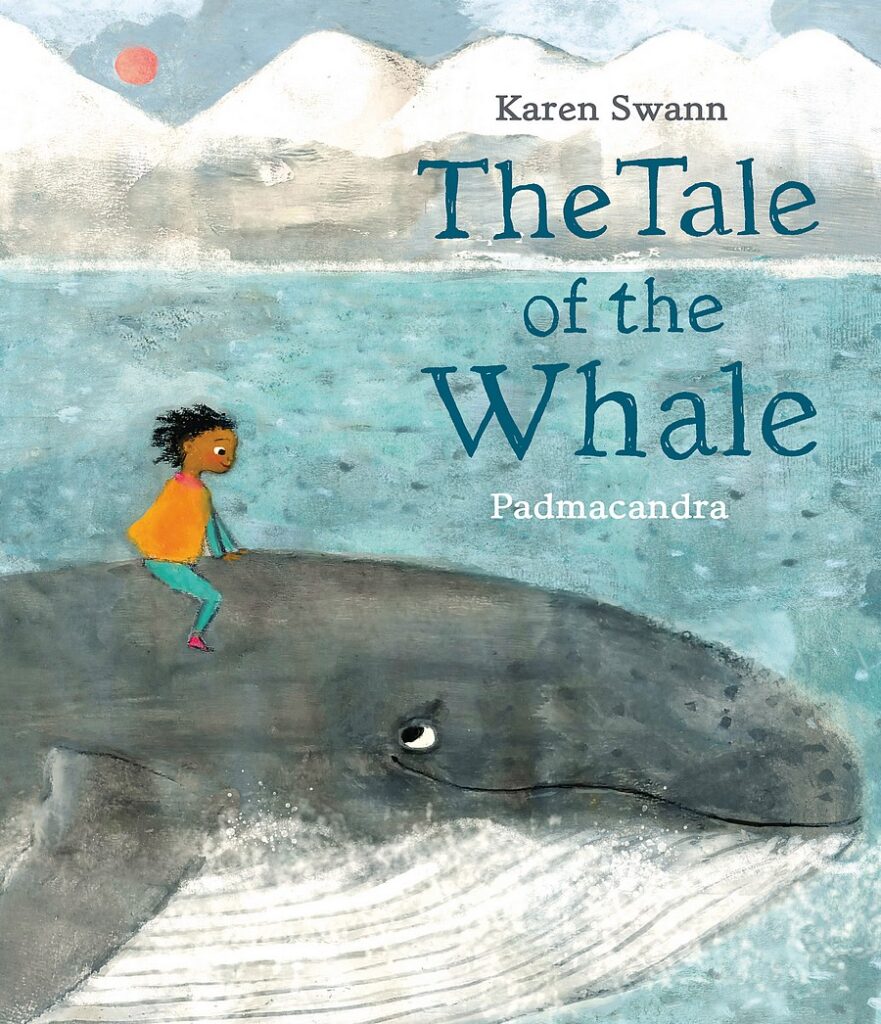
The Tale of the Whale is a stunning literary and visual masterpiece by Karen Swann, illustrated by Padmacandra and published by University of Queensland Press (UQP). Right from the moment the cover is opened the story begins on the endpapers. The title page is a visual treat as it is difficult not to be drawn to the illustration featuring a headland that resembles a whale in both colour and shape. This mesmerising, creative title page demands attention as it is filled with details that give clues about the setting of the story and highlights the different ways the local population interact with the ocean.
The gentle, lyrical narrative tells the story of a young child’s adventures with a whale and the beautiful connection they share as they explore the glorious depths of the ocean in all its colourful majesty. Their adventures are filled with awe as they behold the astonishing beauty to be found in the sea. Their travels result in the whale gaining a large appetite, so the whale opens its mouth and ingests “the soup of the ocean”, which is a stark contrast to the stunning vibrant colour and wonder that the child and whale had the privilege of experiencing together. Instead, this ocean soup is made up of the vulgar plastic waste that humans discard and ends up in the ocean.
The story highlights in a powerful and non-didactic way, the devastating impact the ocean soup has on the ocean life.
A detailed review for The Tale of the Whale including activity suggestions and a link to teachers’ notes has been written in an earlier Reading Opens Doors blog post here.
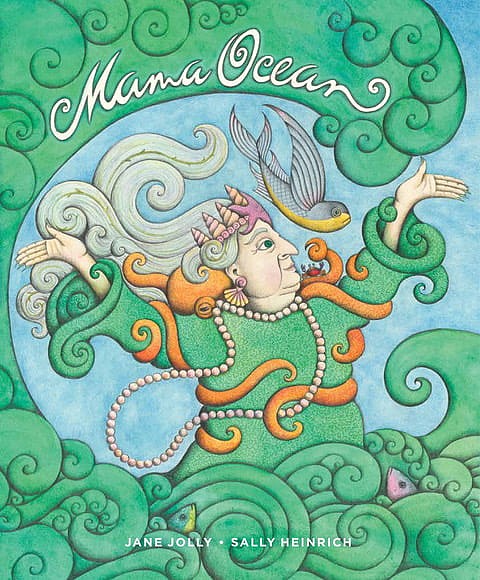
Mama Ocean by Jane Jolly and Sally Heinrich and published by MidnightSun Publishing is a charming cautionary tale about protecting the oceans. This picture book will transport you to the depths of the ocean as you follow the wise and majestic Mama Ocean, whose health reflects the quality of the marine environment.
In this cautionary tale, the strong and commanding Mama Ocean becomes sad and her concerned children (the sea creatures, of which there are many represented in this stunning story) attempt to lift her spirits by presenting her with attractive ‘gifts’ that they source from the ocean. Unfortunately, their resourcefulness does not seem to help Mama Ocean. Mama Ocean becomes increasingly unwell as “she was becoming bleached and frail. Her eyes were dulling”. The sea creatures are not aware of the damaging effects of the ‘gifts’ they found bobbing around in their home and how they are responsible for making Mama Ocean sick. After deep reflection and a desire to help Mama Ocean, the sea creatures come to the realisation that the gifts are dangerous and harmful to the ocean. They declare, “this finery is fake” and work together to rid the ocean of this toxic pollution.
A detailed review for Mama Ocean including a link to teachers’ notes has been written in an earlier Reading Opens Doors blog post here.
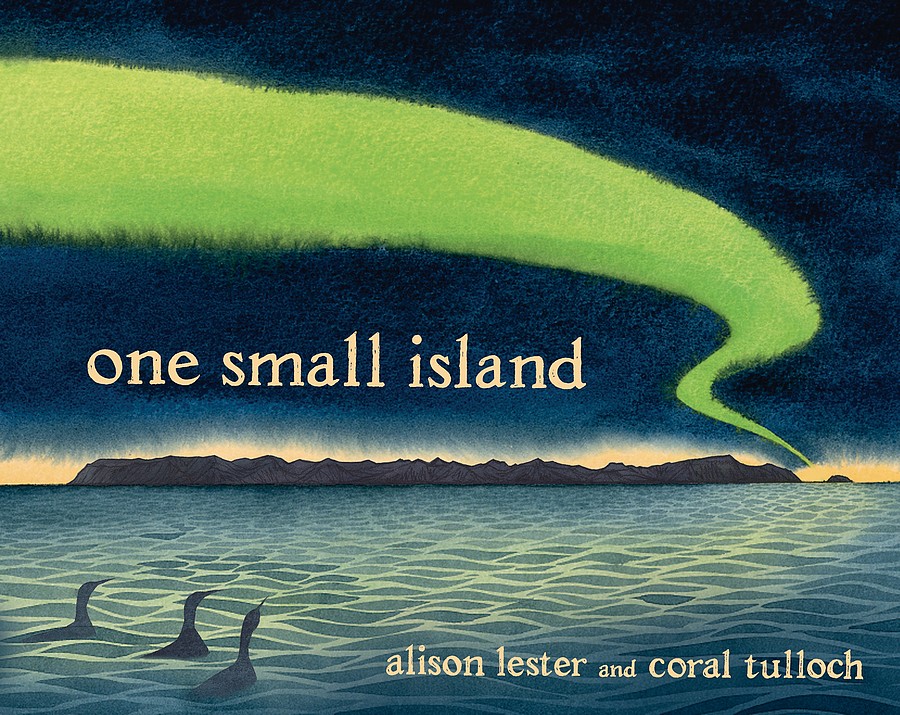
One Small Island co-authored and co-illustrated by Alison Lester (who created the seascape pages) and Coral Tulloch (whose pages are in the style of a journal with comprehensive scientific information and includes letters, maps, drawings of animals and other highly fascinating details) is the story of Macquaire Island, a small island that lies in the southern ocean between Antarctica and New Zealand. This is a story about the history of a once pristine island thriving with animals and plants that was inhabited by seal gangs who initially hunted fur seals. Once this population was depleted the sealers went on to hunt elephant seals and then the island’s penguins. The sealers introduced foreign species which resulted in devastating consequences for the natural food chain and ecosystem. This book highlights the vital work conservationists do and how their efforts can rescue extremely endangered species and their home.
This meticulously researched story begins on the endpapers which also contains glorious maps and information. This book explores how the island was formed and shares information about the pristine conditions prior to human inhabitants. This was an island thriving with wildlife. The year 1810 saw humans discover seals on the island. The discovery of the existence of seals lured the hunters and over time one hundred thousand fur seals were killed. By 1820 fur seals no longer inhabited the island and hunters turned to the elephant seals for their oil. Several different animals were introduced to the island by the sealing gangs, including rabbits and wekas to bolster their food supply and the introduced cats hunted the Macquarie Island parakeet. In 1911 Douglas Mawson’s expedition included Macquarie Island and a team resided on the Island for two years to study the island. They advocated for protecting the island’s animals after witnessing the barbaric practices from the seal gangs. In 1933 Macquarie Island was declared a wildlife sanctuary, penguins and seals became a common and growing sight on the beaches again. However, cats preying on birds and rabbits eating the plants were wreaking havoc and ravaging the island. In 1948 the Australian government set up a scientific station on Macquarie Island. The introduced species continued to severely threaten the island and attention turned to eradicating them. With the reduction of cats on the island, the rabbits had lost their main predator and went on to demolish vegetation that provided a safe haven and shelter for the birds. An eradication program (the use of poison baits) was introduced in 2010 to finally rid the island of rodents and rabbits which also had consequences for all animals on the island. This important story finishes with a message of hope. At the end of the book is a timeline and glossary.
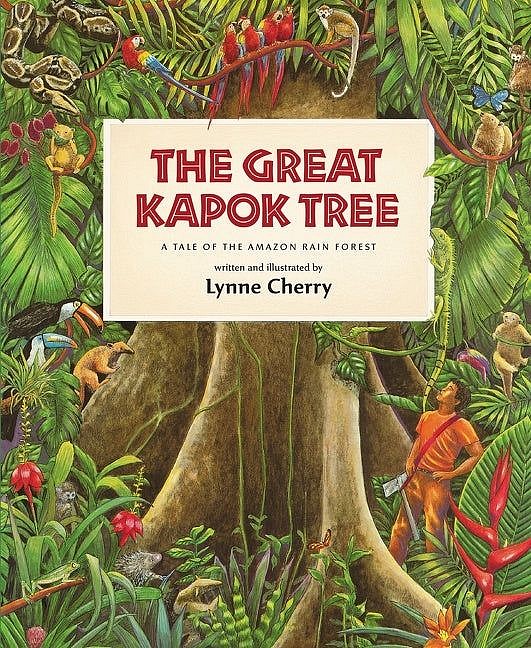
The Great Kapok Tree written and illustrated by Lynne Cherry for readers in early primary school is about the Amazon rainforest. The book begins with a note to the reader and a call to action, followed by an introduction to two different layers of the rainforest, the canopy and the understory as well as the animals that live there. Two men enter the lively rainforest that is full of sound, but quickly descends into silence as the animals quietly observe the men. The natural sounds of the animals are replaced with a man striking blows to a Kapok tree. This is tiring work, exhausted the man rests by the base of the tree and drifts off to sleep. While sleeping, the man is paid a visit by several animals from the rainforest – a boa constrictor, a bee, troupe of monkeys, various different birds, a frog, jaguar, porcupines, anteaters, and a sloth – all with a message for the man highlighting the significance of the tree, not only for present time, but also the future. The animals refer to the fragility of the ecosystem and how all living things are interdependent. They also communicate the devastating and irreversible consequences of cutting down the tree. The animals talk about the loss of habitat for the rainforest animals and how cutting down the Kapok tree will disrupt the food chain. The birds, who have a birds eye view of the rainforest, tell the man about their experiences and observations when one tree is cut down. They state that more land is cleared, people then inhabit the land and the forest is replaced with building structures causing a massive loss of habitat for the rainforest animals. The sloth has a message about the beauty of the forest. After the animals visit the man, a child from the Yanomamo tribe who resides in the forest has a plea for the man “when you awake, please look upon us all with new eyes”.
Soon after, the man awakes to a mesmerising sight surrounded by all of the wondrous animals and the child. It is a true sensory experience for the man who sees so many spectacular sights, the scents of the perfume in the flowers delight him and he feels the steamy mist of the forest. The man is about to continue chopping down the Kapok tree and has a change of heart. The child’s plea is answered as the man leaves the forest.
The exquisite, meticulously researched (Lynne Cherry travelled to the Amazon rainforest to study and observe the rainforest for the illustrations),lush and lively illustrations give the reader a glimpse into the forest and truly bring it to life.
This non-didactic powerful story for younger readers illustrates the ecological significance of not cutting down the trees in the Amazon rainforest.
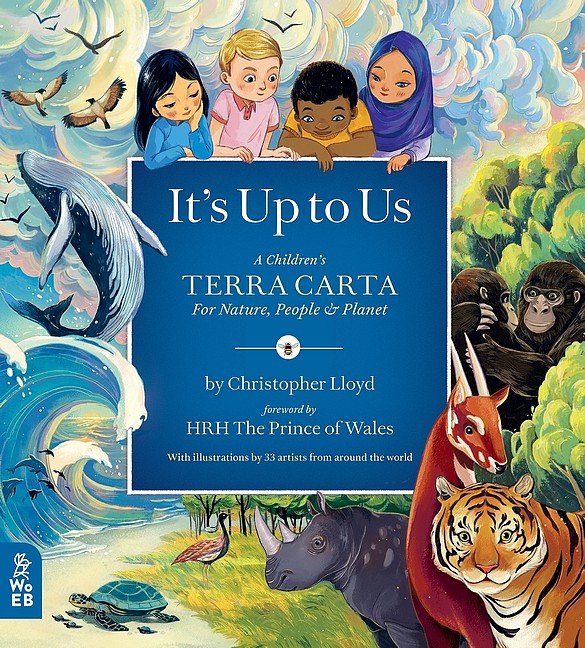
It’s Up to Us: A Children’s Terra Carta for Nature, People and Planet by Christopher Lloyd, foreword by HRH The Prince of Wales with illustrations by 33 illustrators from around the world.
This is a powerful, thought-provoking non-fiction book featuring a story of hope and activism and is “based on the Terra Carta – a road map that was created by HRH The Prince of Wales and the Sustainable Markets Initiative to put Nature, People and Planet at the heart of global value creation”. This book reinforces the idea that we are caretakers of this precious earth and is a call to action to inspire young readers to adopt sustainable practices and environmental responsibility.
A detailed review for this title has been written in an earlier Reading Opens Doors blog post here.

The All New Must Have Orange 430 by Michael Speechley is a sophisticated picture book that explores themes relating to consumerism, waste, impulse buying, the power of advertising, creativity and imagination as well as sustainability. In this story, Harvey, surrounded by chaotic bunches of stuff, buckets and storage containers brimming with all kinds of the latest and greatest toys has been anticipating the release of a brand new whiz bang product, and the sense of urgency in the advertising impresses upon him that he must purchase the Orange 430 immediately. Only one problem, he has depleted all of his savings. He scrounges together every cent he can find to ensure he done not miss out and proceeds to purchase, sight unseen, this must have product. No consideration goes into what he is going to use this item for, where it’s going to be stored or nor does he do any research into this item.
At the store, undeterred by the “April Fool’s Sale” sign, and unperturbed by the fact that the Orange 430 sat alongside a range of odd products such as a lead balloon, fat free fat and dead batteries to name a few, Harvey is elated to find the Orange 430 and scoops up his new prized possession, holding it high like a trophy. In his rush to buy, he may have missed some key information written on the box which the astute reader will spot as it says clearly, “useless object”.
The feelings of elations are quickly replaced on closer inspection of the product as Harvey struggles to identify a use or purpose for the Orange 430.
At UOI (Useless Object International) where Harvey finds himself in an attempt to return this item, he joins a long queue of other dissatisfied, disgruntled shoppers who look deeply unhappy and discontent. They also want a refund. It becomes clear that this purchase does not fuel anyone’s happiness, or lead to any sort of connection to the Orange 430. Harvey found that no one could find a use for their Orange 430. The product may not have been useful, enjoyable or satisfying, but the people in the queue use their imaginations to find alternative uses for the box the product came in and have all sorts of fun.
It was while Harvey was observing all of the creativity and antics going on around him that he had a realisation. In fact, the more he thought about his useless purchase the more he pondered, discovered and vowed to change his impulse buying habits and the impact this may have.
Michael’s illustrations are featured in sepia tones with the only pops of colour relating to the Orange 430 and other useless objects people have purchased, for example the Blue 125. This colour palette highlights the discontent, the feelings that are derived from the insatiable quest for the next best thing, a compulsion to buy and the fleeting thrill that ensues followed by emptiness. There is so much to unpack in the highly detailed illustrations, opportunities to strengthen visual literacy skills abound in this book.

The Tantrum That Saved the World co-authored by Megan Herbert and Professor Michael E. Mann and illustrated by Megan Herbert, is a timely book that would make an invaluable addition to any library collection about climate change, activism and hope. This empowering and highly engaging solution focussed story, written for readers 5-9 years, in rhyming couplets is about the science behind climate change, its effects and the positive steps that can be taken for world saving action (which are in the story and also documented on an aesthetically attractive poster included on the final endpapers). This story highlights the effects of human impact on the earth and the role everyone can play to help restore nature’s balance. It is an inspiring call to action to inspire young readers to adopt sustainable practices and environmental responsibility.
In this story, a young girl, Sophia, is visited at home by a number of unexpected and surprising guests. To her astonishment her house becomes filled with animals and people who have been displaced because of climate change which has adversely affected their homes, land and habitats. These climate refugees each have their own unique story, but share in the common threat which the people of the world can collectively take action to help. The first visitor is a polar bear whose home is threatened by global warming, causing the sea ice to melt making it impossible for the polar bear to source food. Next a family from Kiribati affected by rising sea levels arrives at Sophia’s home. Animals promptly follow including a swarm of bees who are unsure of the season and are adversely affected by climate change. The shifting temperatures are disrupting and changing the natural rhythm of the seasons and this in turn negatively impacts the relationship between flowering plants and the pollinators. A poorly flamingo joins the group as its food chain has been disrupted and this displaces the flamingo that is usually a non-migratory bird. Farmers and a seaman also turn to Sophia as drought has devastated the farmers who are unable to produce crops in severe and prolonged droughts. The fisherman has been affected as some fish species have migrated to waters where the temperatures are cooler and this upsets the delicate balance and leads to gaps in the food chain. One of the final unexpected visitors is a Bengal tiger whose home, the mangrove forests, has been threatened by deforestation and habitat loss. Rising sea levels will exacerbate the critically dangerous situation and destroy its home.
Initially Sophia is confused as to why these animals and people in trouble have come un-invited to her. She feels powerless to resolve their problems. Then, in an epiphanous and powerful moment, it becomes crystal clear these people and animals need Sophia’s help and “compassion is key”. Sophia takes charge and visits City Hall to speak to the powers that be. They are dismissive and display a parochial view. However, Sophia is on a mission to ameliorate the situation and she has every reason to continue the fight, with or without the authorities support. Sophia, armed with the knowledge about the impact of climate change on how it is affecting the seasons, weather, farms, food chain, habitats and homes of people and animals all around the world, starts educating the people and calling them to action through a protest. She is confronted by a man in a suit telling her that “we’ve done all we can. You don’t understand”. Sophia more than understood and this man’s egregious actions fuel her to begin a “tantrum to save the world”. Immutable in her conviction, she unifies people, spreads the message about the importance of cooperative action. She speaks to groups advising of strategies they could employ, puts pressure on the government and this has a far reaching ripple effect and helps enact mass change.
Together, a difference had been made, all of the people and animals now have a second chance and leave Sophia’s home, happy and confident with a sense of purpose. Sophia’s important work does not stop here, she continues to galvanise her community and speak to world leaders.
At the end of this story is information for readers about global warming and climate change which has been written in a highly accessible way. Words are included in italics and these are documented and explained in a glossary which appears at the end of the book. There are several pages explaining the stories behind each of the climate refugees that visited Sophia. This information is presented concisely and in an interesting way for young readers.
This story, the world’s first carbon-neutral climate change children’s book, educates readers about the benefits of working collectively to protect the environment and be part of contributing to a healthy, strong planet for all of the flora, fauna and future generations.
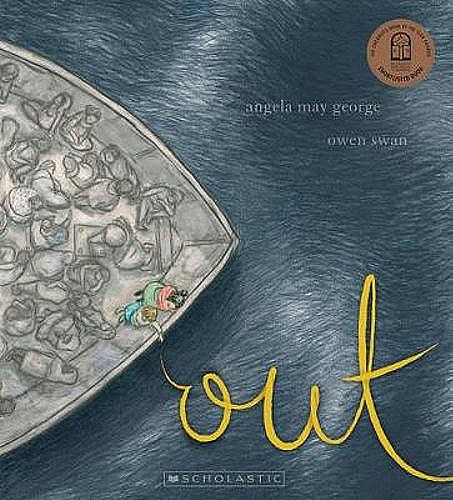
Out by Angela May George and illustrated by Owen Swann shares the journey of a mother and daughter fleeing their country to seek asylum and this story is told from the viewpoint of the young girl. With no other choice, they make the agonising decision to leave their war-torn land and embark on a journey fraught with danger and the real possibility they may pay the ultimate price, their lives. The story shares how they hide from soldiers in a bush setting before embarking on a very long, arduous journey on a boat that feels like an eternity and eventually arrive in a new country. The story then explores their lives after they have arrive, the obstacles that arise and they overcome, the lessons to learn and how their thoughts constantly turn to their home as they both wonder what has happened to their father/husband who they desperately miss. The story also discusses the joy and freedom they feel as they explore this new land. The illustrations are evocative and visually arresting. This story has wonderful opportunities to explore visual literacy elements – the yellow ribbon on each page, the various angles used, the use of colour and how it changes throughout the book (beginning with muted tones that become more colourful as the story unfolds), how movement is portrayed (in the ocean, the ribbon moving). It is a hope filled story that humanises the refugee experience, fostering empathy for the refugees and ultimately making this story accessible for young readers.
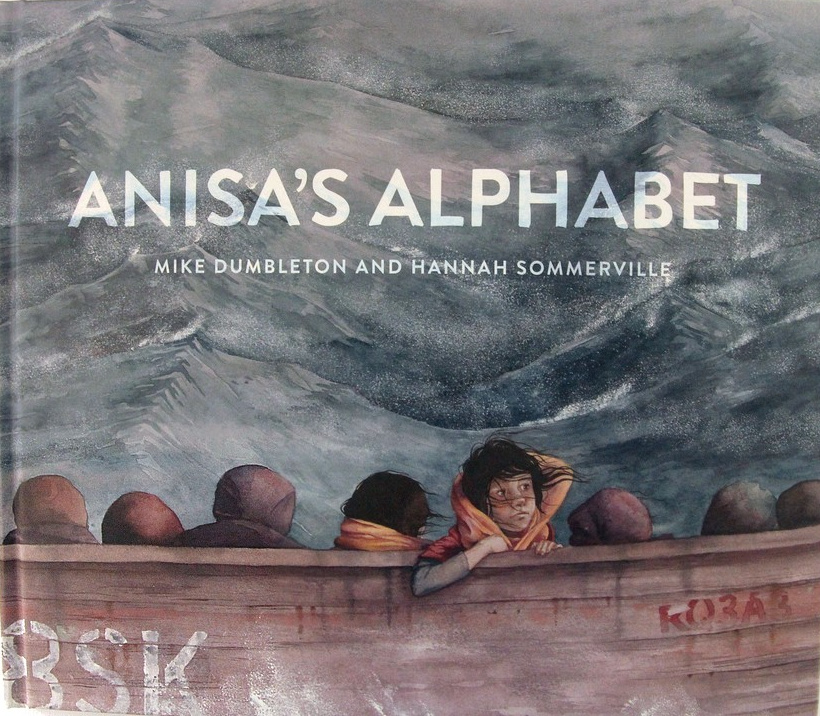
Anisa’s Alphabet by Mike Dumbleton, illustrated by Hannah Sommerville and published by MidnightSun Publishing is a picture book told in rhyming text. This book is about Anisa’s moving story of her refugee journey from a war torn county to a new land in the hope for freedom. Each letter of the alphabet is used to reveal another key part of Anisa’s story which is told from her perspective. The illustrations are captivating and reveal so much about Anisa’s experiences, as well as those of her family and other refugees with her. It is interesting to note that the refugees depicted in this book are often illustrated in silhouette form, or outlined with their backs facing the reader in contrast to Anisa and her family who are prominent in the illustrations. The refugees we do not ‘see’ could just as well be the many individual refugees stories that are not heard or told. Hannah’s illustrations in muted tones convey the threatening and often dire situation that Anisa and her family face, while the coloured drawings by Anisa that are included capture her optimism and hope. Even though the themes are difficult and heavy, Mike Dumbleton and Hannah Sommerville have told this story in a way that is accessible for children. This thought provoking picture book will spark many conversations about refugees and their experiences.
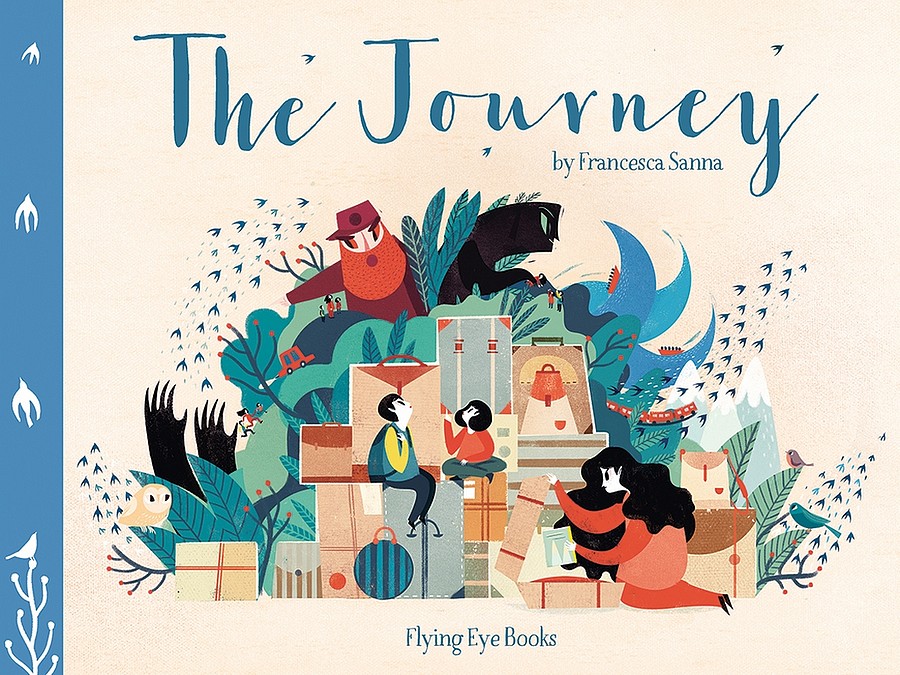
The Journey by Francesca Sanna is a picture book inspired by interviews the author had with many people who had left their homeland. This book tells the story of many who leave behind all that they know and love and make the perilous journey, fraught with danger and no guarantees. The story where people have no choice but to be courageous in such harrowing circumstances and display immense human strength as they endure unimaginable fear and loss in an attempt to defy the odds.
This story, narrated by a young child explaining her family’s circumstances in an unspecified location, begins with a day at the beach and how this once treasured place is a destination they no longer visit as their lives have irrevocably changed. A war has started and plunges everything into a state of chaos. First the war claims their father, then their home as the children’s mother makes the agonising decision to flee to another country. Suitcases are packed and the physical journey of moving begins. The mother tells her children it will be “a great adventure”. They use different modes of transport and each one demands less luggage on board, so the further they travel, the more of their possessions they sacrifice. After days of gruelling travelling they arrive at the border only to be confronted by a guard who refuses them entry. With no choice, they sleep in the forest only to be woken by more guards. They are on the run again. They meet an unfamiliar man, money is exchanged in return for this man to take the mother and children over the border. The journey continues as the family must cross the ocean. They board an overcrowded boat and endure an arduous journey. More turmoil. Storytelling brings them comfort and hope. Once they disembark there is still more of the journey to be had, this time a train takes them over more borders. The child sees birds flying above the train and hopes that just as the birds are migrating, she will find a new home just like them and start a new story. Their journey has not ended.
The restricted colour palette is contrasted with black menacing shapes that have an anthromorphic quality to them with what appears to be claws at the end reaching out towards the family, representing the threatening, looming and ever present danger of war. As hope fills the family the use of these black shapes is reduced. Also in the illustrations the astute reader will notice the birds migrating and draw parallels between this and the family leaving their home in search of a new one.
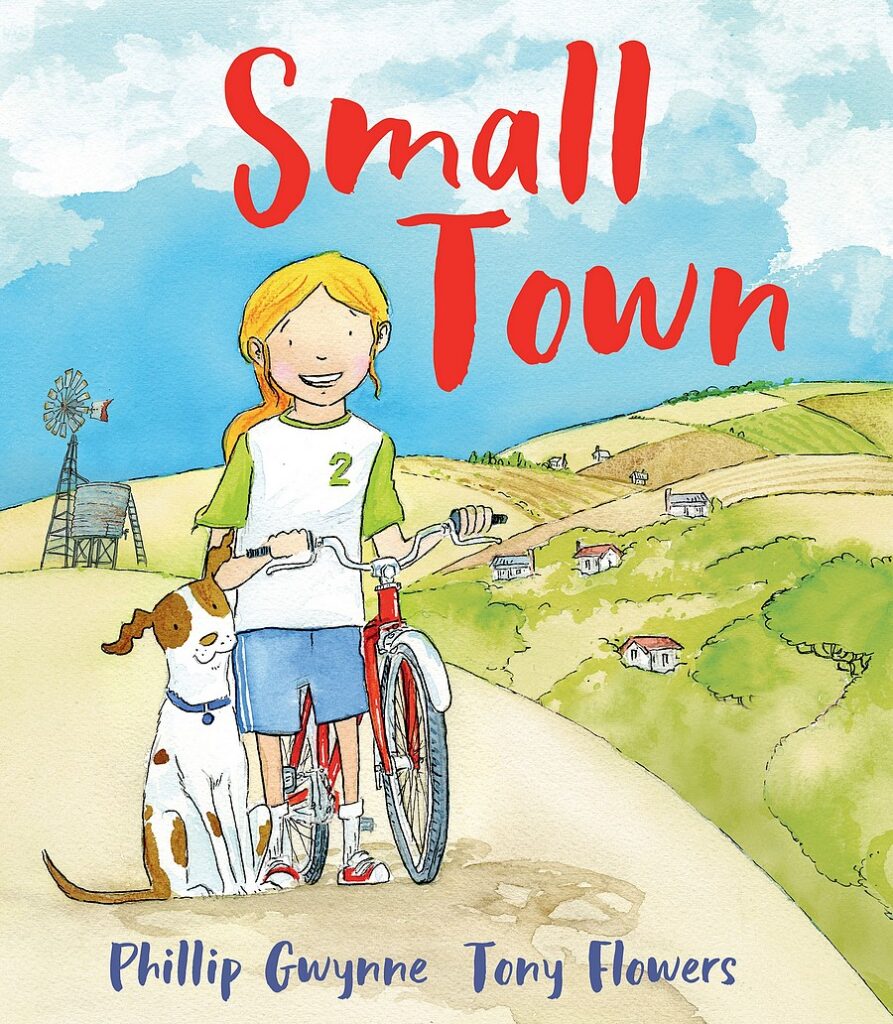
Small Town by Phillip Gwynne and illustrated by Tony Flowers is an uplifting celebration of small rural towns and people power. The narrator of this picture book is Milly, a proud resident of Gong Gong. Milly is troubled by the number of people leaving her town and decides to take action. After learning about refugees at school, Milly decides to write a letter to refugees inviting them to live in Gong Gong and explains some of the benefits of living in her town. Millie’s Granny Mac believes a video would be the perfect addition to her letter, so together they record all of the unique and wonderful opportunities as well as experiences their rural town has to offer. The detailed endpapers are incredible and tell the story about the positive impact refugees can have on a small rural community. The illustrations by Tony Flowers add another layer of warmth to this powerful story. This book explore complex issues such as downturn in regional towns, the pull to the city for employment and opportunities and the impact this has on rural towns, community, activism, grandparents as role models, refugees, the settlement of refugees in Australia and the positive impact they have.
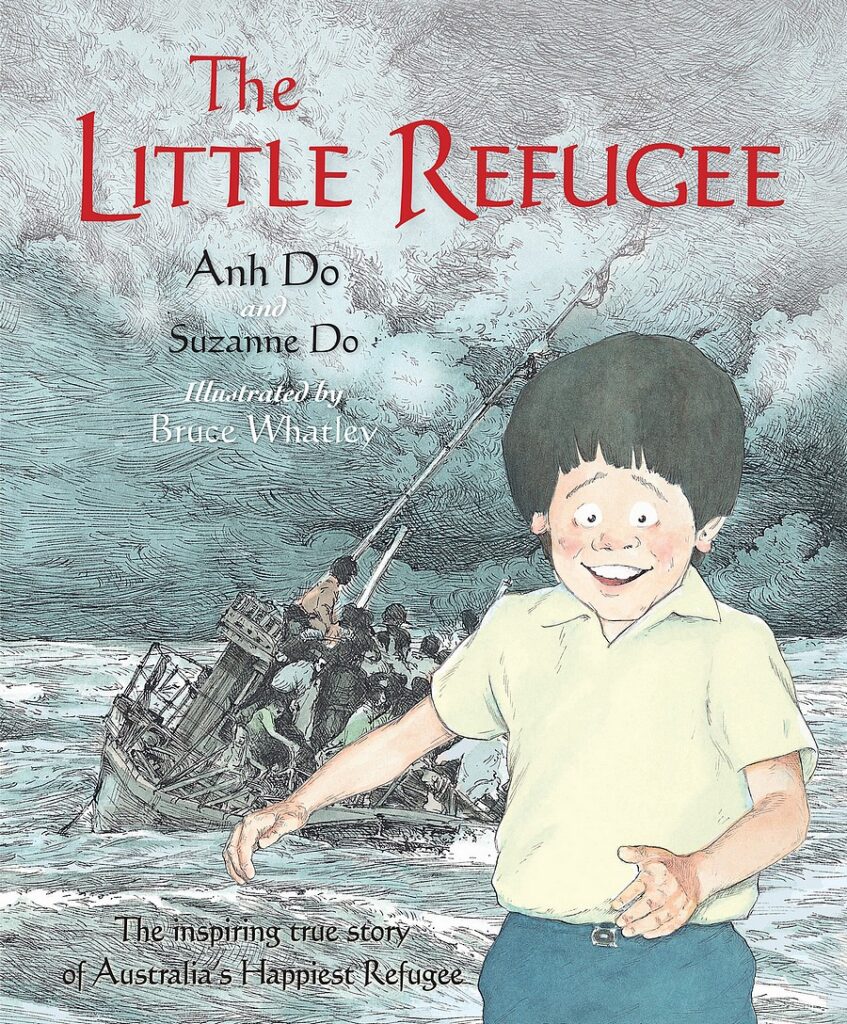
The Little Refugee by Anh Do and Suzanne Do is a powerful picture book inspired by Anh Do’s award-winning memoir, The Happiest Refugee. This story begins in Vietnam, with Anh Do as a happy young boy, enjoying his childhood surrounded by family and love. Oblivious to him as a young boy, his country was involved in a war. After the war, his family were forced to flee their home and country. They fled on board a fishing vessel with other family members, neighbours and friends, forty people in total crossed the ocean on what was a treacherous journey, at times harrowing where they feared for their lives and eventually arrived in the safe haven of Australia. Anh Do’s Mother, despite intense danger, loss and uncertainty never gave up hope. She said to Anh that “you must always have hope that things will be okay”. She saw the positives in hard situations and never took for granted the good that was in their lives. Her resilience, perspective, gratitude for the chance for a better life and strong work ethic were valued and role modelled to And Do and his brother. Anh Do shares some of the struggles his family and him experienced in a foreign country, as well as the triumphs. Despite the heavy themes, this is a story of hope, courage and overcoming adversity. There is so much to gleam and read in the illustrations. There are two contrasting styles of illustrations used by Bruce Whatley – one is more of a contemporary style with cartoon like illustrations. The other style features illustrations that are more photographic like and a sepia colour palette is used, evoking nostalgic feelings to depict what life was like for Anh Do in Vietnam and scenes from the boat trip to Australia.
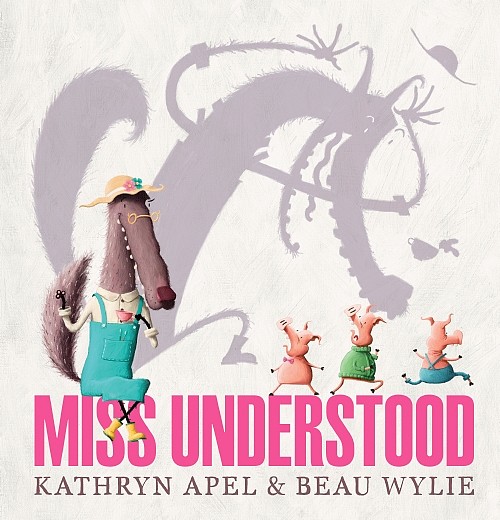
Miss Understood by Kathryn Apel and illustrated by Beau Wylie is a fractured fairy tale and is a brilliant book to use when exploring perspective to consider a traditional fairy tale (in this case ‘The Three Little Pigs’) from a different point of view. Miss Understood is told from the wolf’s perspective and is a telling of her version of events. She claims “those Little Pigs told you a porker” and the sweet and innocent wolf is here to set the record straight once and for all.
Could it be that the wolf is indeed misunderstood, could readers have been biased in forming their opinions about the wolf and have the wrong idea about her – there’s always two sides to every story, isn’t there?
In this rollicking rhyming picture book, the reader is introduced to a wolf that appears good hearted, innocent and is kind and generous to the three smug looking pigs. The wolf approaches Pig’s hay house bearing sweet gifts. The unwelcoming pig, completely aware of the wolf’s allergies, slams the door in wolf’s face. The hay from the home becomes airborne because he slammed the door so hard and this triggers the wolf’s allergy. The wolf is desperate to stifle this and tries everything in her power to curtail the symptoms, but all to no avail and the damage is done. Miss Understood feels dreadful and wants to apologise for her actions which were beyond her control and truth be told were actually caused by Pig.
Miss Understood is unable to apologise to Pig as Pig flees the destruction and spreads “lies” about the course of events. This sets Miss Understood on a course of misadventure, none of which is her fault, but results in a series of calamities. The Pigs were quick to spread the word that Big Bad Wolf was after them. The Pigs are ruthless and tell their story wide and far, leaving the wolf lonely, isolated, feared and unfairly accused of crimes she did not commit. This leaves wolf with a damaged reputation when really she is misunderstood.
A detailed review for Miss Understood has been written in an earlier Reading Opens Doors blog post here.
